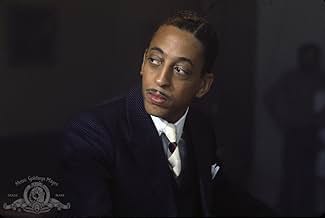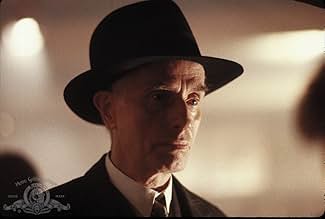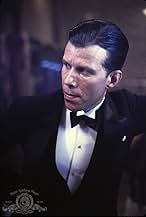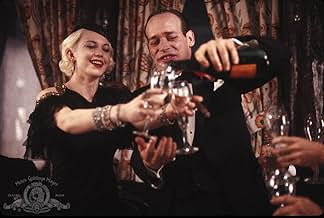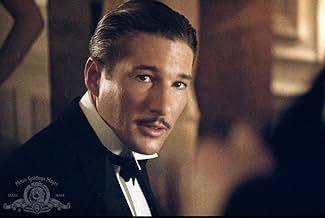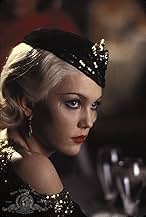CALIFICACIÓN DE IMDb
6.6/10
21 k
TU CALIFICACIÓN
Conoce a los músicos de jazz, bailarines, propietarios e invitados del Cotton Club en el Harlem de 1928 a 1930.Conoce a los músicos de jazz, bailarines, propietarios e invitados del Cotton Club en el Harlem de 1928 a 1930.Conoce a los músicos de jazz, bailarines, propietarios e invitados del Cotton Club en el Harlem de 1928 a 1930.
- Dirección
- Guionistas
- Elenco
- Nominado a 2 premios Óscar
- 1 premio ganado y 9 nominaciones en total
Laurence Fishburne
- Bumpy Rhodes
- (as Larry Fishburne)
John P. Ryan
- Joe Flynn
- (as John Ryan)
Opiniones destacadas
inspired by photographs of the legendary Cotton Club in Harlem, some shots appear exactly as they were (now in colour). I noticed Dutch Schultz's slumped pose when he is shot is exactly that of the police photograph, though he died several hours later (see William Burroughs "The Last Words Of Dutch Schultz"). The actors often play too broad (Diane Lane), and Richard Gere shows his lazy, grinning acting here too. However, many notable smaller roles for Gregory Hines (and his brother), Bob Hoskins, Laurence Fishburne and others who make it well worth watching. It is true that $40 million could have been used better, but when you consider both Bob Evans and Coppola's involvement it seems with hindsight that they were asking for trouble. The music deserves special credit, as do the tap sequences (which i gather were shortened and some cut - what a shame). Mostly Duke Ellington classics. As i've already suggested the look is a perfect recreation of the time, but sadly the plot is patchy, some dialogue weak and it has been said before - there is no chemistry between the romantic leads. 9/10
The first time I saw this movie I loved the music and dancing and appreciated the setting. I found it strange and couldn't follow it properly. I watched it a second and third time, partly to see the dancing again, and listen to the music, and the plot completely grew on me. I absolutely love this movie. It is complex, and extremely accurate in its portrayal of the time when gangsters owned stars. If you love jazz music and know a little about its history, you will be enraptured by this movie.
The acting is incredible, and highlights the subtle twists in the plot beautifully. The cinematography is done in a most expert fashion. Richard Gere and Gregory Hines are absolutely charming, and Diane Lane is perfect is Vera Cicero. Lonette McKee has one of the most beautiful voices you will ever hear, it is no wonder she received a Tony award. Any viewer will be surprised by the guest appearances including Nicholas Cage, Bob Hoskins, Lawrence Fishburne, and on-screen and real-life brother of Gregory, Maurice Hines. Not only one of Coppola's best, but one of the best of all time.
The acting is incredible, and highlights the subtle twists in the plot beautifully. The cinematography is done in a most expert fashion. Richard Gere and Gregory Hines are absolutely charming, and Diane Lane is perfect is Vera Cicero. Lonette McKee has one of the most beautiful voices you will ever hear, it is no wonder she received a Tony award. Any viewer will be surprised by the guest appearances including Nicholas Cage, Bob Hoskins, Lawrence Fishburne, and on-screen and real-life brother of Gregory, Maurice Hines. Not only one of Coppola's best, but one of the best of all time.
I saw this movie when it first came out and I thought it was a mess. Now years later while I have the luxury of sitting in my house watching the various showings on cable, I like a better. Why because this movie is IMO 3 different movies going on at once. I Now I am able to concentrate on one aspect of the movie more then the whole.
I will start with movie #1... The Cotton club, the nightclub where everything converges and what is the common denominator that brings ALL of the characters together. It is almost set up like a Plantation in Mississippi. The white gangster own the place and the black people work there and have no say about anything that goes on. Black people were not even able to go to the club as a customer. All of the women who worked there were light skin almost passing for white. In the movie they do show how the set up was but the place was no as large as it was in the movie and on a side bar. Larry Fishburn who plays a numbers runner (the same role he played in a later movie, Hoodlum) shows interest in a brown skin singer performer in the club and her mother is very upset because she is the first "dark skin" woman working at the club. I liked that they added that in. I know this because my neighbor use to play with Louis Armstrong that the women in question is in fact Louis Amstrongs future wife. A little tidbit. I like the music and the performances which took place in the club. To me this was the most enjoying part of the movie. I feel a movie just about the Club without all the other foolishness it would be very interesting in the right hands. Which brings me to movie 2
THe gangsters or the white people. Owey Madden was a thug and a very nasty man. In this movie Bob Hoskin (who was very good) and Fred Gwynn who I loved played like they were Fred Flintstone and Barney Rubble. In the right hands we would of seen the real Madden. Remember this is the man who kept black people out of his club. And did battle with other NY gangsters. Then we have Dutch Schultz. I wonder why we did not see more of Lucky Luciano because it was those 2 who were causing havoc in NYC during the 20's with Luciano winning. I think James Remer did the best portrayal of Schulz. Years later Tim Roth played him in the movie Hoodlum and he was good, but Remer was scarier. And according to all reports he was a psychopath. Then we have the George Raft(Dixie Dwyer) character played by Richard Gere If people are not familiar with the actor George Raft it was known he hung around the mob and had big time mob connections..who actually got him a job in movies. Richard Gere even mentions at one time that he use to be a dancer. I am sure that is reference and acknowledgment of George Raft, who was a dancer before he went to Hollywood. George Raft was actually a pretty good actor. Gere even looks like him. I feel that is the real reason they cast him in this movie. Look at this movie as Gere playing Raft and not playing Dixie Dwyer and the part works.
The last movie is the Harlem story. The Larry Fishburne character was a real person. He was lifetime criminal who spent most of his life in jail. He was not the voice of righteousness we see in the movie or the movie Hoodlum. What was interesting was the scene when he and the woman who was running the numbers racket in Harlem were offered a deal. I like they put that in the movie, that was true. The woman who was the real boss of the numbers racket came from the West Indies and started the whole thing on her own. A very tough cookie who went to jail because she would not give in to the mob. The mob was politically connected and they put her in jail for a long time. I like the the Hines bothers in the movie. They were feuding in real life and this movie was a way they starting talking again. They actually showed that in the movie. ALso the Vonnetta McGee character was interesting. I am a very light skin black women who could pas for white. WhICH I WOULD NEVER DO. But I don't know about living back in the early part of the century. The scene when she and Sandman goes to the hotel and the clerk tries to deny them a room actually happened to me and a boyfriend of mine years ago. So that scene really hit me. I would of liked if they explored Harlem life more, but the movie had too much going on already.
Nicholas Cage...nephew of Cappolla was good playing the violent brother of the Richard Gere character. I would like to have seen him in more parts like that instead of the garbage he has been wasting himself in the last few years. Diane Lane was the miscast. She was playing a real character too, but she came nowhere near the woman she was playing, Texas Guinon(I think that was her last name) A big boozy tough blonde. To me that is the major miscast of the movie. I like her though, but not in this movie. This is a movie I feel has to be seen around 5 times to get the whole feeling of it. A good movie but just too messy and too much.
I will start with movie #1... The Cotton club, the nightclub where everything converges and what is the common denominator that brings ALL of the characters together. It is almost set up like a Plantation in Mississippi. The white gangster own the place and the black people work there and have no say about anything that goes on. Black people were not even able to go to the club as a customer. All of the women who worked there were light skin almost passing for white. In the movie they do show how the set up was but the place was no as large as it was in the movie and on a side bar. Larry Fishburn who plays a numbers runner (the same role he played in a later movie, Hoodlum) shows interest in a brown skin singer performer in the club and her mother is very upset because she is the first "dark skin" woman working at the club. I liked that they added that in. I know this because my neighbor use to play with Louis Armstrong that the women in question is in fact Louis Amstrongs future wife. A little tidbit. I like the music and the performances which took place in the club. To me this was the most enjoying part of the movie. I feel a movie just about the Club without all the other foolishness it would be very interesting in the right hands. Which brings me to movie 2
THe gangsters or the white people. Owey Madden was a thug and a very nasty man. In this movie Bob Hoskin (who was very good) and Fred Gwynn who I loved played like they were Fred Flintstone and Barney Rubble. In the right hands we would of seen the real Madden. Remember this is the man who kept black people out of his club. And did battle with other NY gangsters. Then we have Dutch Schultz. I wonder why we did not see more of Lucky Luciano because it was those 2 who were causing havoc in NYC during the 20's with Luciano winning. I think James Remer did the best portrayal of Schulz. Years later Tim Roth played him in the movie Hoodlum and he was good, but Remer was scarier. And according to all reports he was a psychopath. Then we have the George Raft(Dixie Dwyer) character played by Richard Gere If people are not familiar with the actor George Raft it was known he hung around the mob and had big time mob connections..who actually got him a job in movies. Richard Gere even mentions at one time that he use to be a dancer. I am sure that is reference and acknowledgment of George Raft, who was a dancer before he went to Hollywood. George Raft was actually a pretty good actor. Gere even looks like him. I feel that is the real reason they cast him in this movie. Look at this movie as Gere playing Raft and not playing Dixie Dwyer and the part works.
The last movie is the Harlem story. The Larry Fishburne character was a real person. He was lifetime criminal who spent most of his life in jail. He was not the voice of righteousness we see in the movie or the movie Hoodlum. What was interesting was the scene when he and the woman who was running the numbers racket in Harlem were offered a deal. I like they put that in the movie, that was true. The woman who was the real boss of the numbers racket came from the West Indies and started the whole thing on her own. A very tough cookie who went to jail because she would not give in to the mob. The mob was politically connected and they put her in jail for a long time. I like the the Hines bothers in the movie. They were feuding in real life and this movie was a way they starting talking again. They actually showed that in the movie. ALso the Vonnetta McGee character was interesting. I am a very light skin black women who could pas for white. WhICH I WOULD NEVER DO. But I don't know about living back in the early part of the century. The scene when she and Sandman goes to the hotel and the clerk tries to deny them a room actually happened to me and a boyfriend of mine years ago. So that scene really hit me. I would of liked if they explored Harlem life more, but the movie had too much going on already.
Nicholas Cage...nephew of Cappolla was good playing the violent brother of the Richard Gere character. I would like to have seen him in more parts like that instead of the garbage he has been wasting himself in the last few years. Diane Lane was the miscast. She was playing a real character too, but she came nowhere near the woman she was playing, Texas Guinon(I think that was her last name) A big boozy tough blonde. To me that is the major miscast of the movie. I like her though, but not in this movie. This is a movie I feel has to be seen around 5 times to get the whole feeling of it. A good movie but just too messy and too much.
Francis Ford Coppola's The Cotton Club is every bit as dazzling, chaotic and decadent as one might imagine the roaring twenties would have been. it's set in and revolves around the titular jazz club, conducting a boisterous, kaleidoscope study of the various dames, dapper gents, hoodlums, harlots and musicians who called it home. Among them are would be gangster Dixie Dwyer (a slick Richard Gere), Sandman Williams (Gregory Hines), a young Bumpy Johnson (Laurence Fishburne) and renowned psychopathic mobster Dutch Schultz (a ferocious James Remar). Coppola wisely ducks a routine plot line in favor of a helter skelter, raucous cascade of delirious partying, violence and steamy romance, a stylistic choice almost reminiscent of Robert Altman. Characters come and go, fight and feud, drink and dance and generally keep up the kind of manic energy and pizazz that only the 20's could sustain. The cast is positively stacked, so watch for appearances from Nicolas Case, Bob Hoskins, Diane Lane, John P. Ryan, James Russo, Fred Gwynne, Allen Garfield, Ed O Ross, Diane Venora, Woody Strode, Giancarlo Esposito, Bill Cobbs, Sofia Coppola and singer Tom Waits as Irving Stark, the club's owner. It's a messily woven tapestry of crime and excess held together by brief encounters, hot blooded conflict and that ever present jazz music which fuels the characters along with the perpetual haze of booze and cigarette smoke. Good times.
This is a great movie. I personally don't think the beautiful Diane Lane could be in a bad flick, she would make the worst one good. I was impressed with Richard Geres musical ability as he played his own coronet and sounded as good as anyone I've ever heard. The dancing was superb, the costumes beautiful and the plot authentic. It took me back to the great musicals of the forties and fifties. I was raised in the waning days of the era of this movie, the thirties, and I could almost hear my Dad talking about the evils of the big cities while we listened to the radio news of gangsters and shootouts. I would recommend this movie to anyone. I rate it 10/10.
¿Sabías que…?
- TriviaWhen Francis Ford Coppola called up Bob Hoskins to offer him a part, the actor didn't believe it was really him. Coppola introduced himself, to which Hoskins replied, "Yeah, and this is Henry the fucking Eighth", and hung up.
- ErroresDuring the montage song Ill Wind there is a shot of coins and bills being poured out. The dimes in the shot are Roosevelt dimes, not produced until 1946.
- Créditos curiososIn the original version, the opening credits were intercut with dancers performing "The Mooche." In the 2019 revision, the dancing is eliminated and the credits roll straight through, but have been joined with straight cuts rather than dissolves. Additionally, Coppola has changed his billing from "Francis Coppola" to "Francis Ford Coppola." Finally, restoration credits have been added after the end titles.
- Versiones alternativasIn 2019, Lionsgate released a director's cut running 139 minutes, titled "The Cotton Club Encore". This version gave more space to the Williams brothers and Lila Rose, restoring three full musical numbers and extending others, and trimming scenes with impersonations of 1920s celebrities.
- ConexionesEdited into Lonette McKee: Ill Wind (1984)
- Bandas sonorasHow Come You Love Me Like You Do?
Written by Gene Austin and Roy Bergere
Selecciones populares
Inicia sesión para calificar y agrega a la lista de videos para obtener recomendaciones personalizadas
- How long is The Cotton Club?Con tecnología de Alexa
Detalles
- Fecha de lanzamiento
- País de origen
- Idiomas
- También se conoce como
- El Cotton Club
- Locaciones de filmación
- Prospect Hall, Brooklyn, Nueva York, Nueva York, Estados Unidos(church, order given at bar, Hoofer's Club, ballroom proposal)
- Productoras
- Ver más créditos de la compañía en IMDbPro
Taquilla
- Presupuesto
- USD 58,000,000 (estimado)
- Total en EE. UU. y Canadá
- USD 25,928,721
- Fin de semana de estreno en EE. UU. y Canadá
- USD 2,903,603
- 16 dic 1984
- Total a nivel mundial
- USD 25,928,721
- Tiempo de ejecución
- 2h 9min(129 min)
- Color
- Relación de aspecto
- 1.85 : 1
Contribuir a esta página
Sugiere una edición o agrega el contenido que falta



